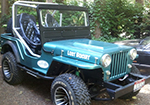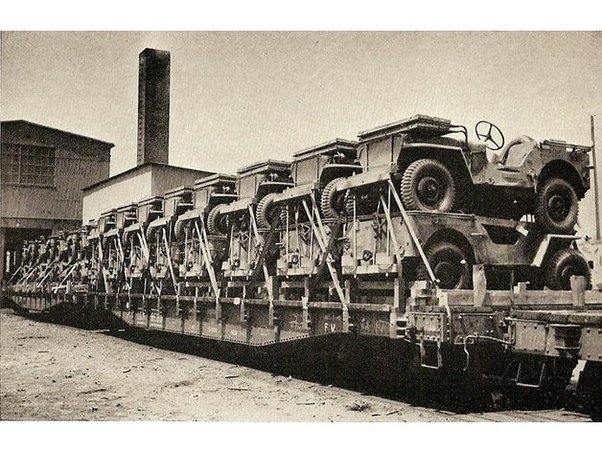Bill shared this article that includes several claims I hadn’t encountered. So, I figured I’d shared this to see what others thought:
- “A little known fact is that most United States wheeled vehicles were designed to stack with only limited modification”?
Was this an actual design goal or a nice to have? Maybe this assertion is true, but I have only see a few examples of stacked jeeps. I can’t imagine the front clip of the Jeep underneath could handle extended shipping in this manner (which, by extension, suggests to me that it was never really ‘designed’ to do this). - “The size of the jeep was dictated by the railroad cars that would carry it”?
Again, this design aspect is news to me. My understanding is that the design was a carryover from the Bantam design, which was a carryover from the Bantam vehicle size. The short wheelbase was excellent for a light weight design and maneuvarability.
- “The mass of the jeep was dictated by the ability to stack up to four high”?
Again, I am unfamiliar with this claim. - “Nearly every part of a jeep is catalog ordered…. The basic army Jeep was the same from start too finish”?
I guess the term “same” would need to be defined, as the basic WWII jeep went through mini alterations over its life. - “Post WW2 when there was a massive shortfall in available farm equipment, there was a period of around seven years when Jeeps were pressed into service as farm equipment.”?
ummm … they were designed, tested, and marketed as farm vehicles starting during war time.
Anyway, check out the article for other claims.


Dave
I did a quick read and quickly got wore out from his assumptions and misinformation.
Interesting in the photo how all the windshield frames are on the top tier.
Looks like early slat grills.
Lots folklore and hearsay in that Quora. Similar to the $50 Jeep in a crate stories.
The army handed out free jeeps to the USPS starting in 1945?? I don’t recall seeing any press photos from that era announcing that, and believe me the PR people would have been falling all over themselves making sure that happened. I doubt there’s any truth to that particular assertion by the author of that article, and if I’m wrong I demand to see some sort of proof.
At least he did name one source – his grandfather. The sad thing is that of the 223.3K readers (viewers), only a few (mostly people here) will question the claims. The farm jeep “facts” will be repeated to me whenever I have my 3a on display. I have developed a rolling library that I take with me. 90% of the time when I offer an alternative set of “facts” people will at least say “That is interesting.” The other 10% I don’t even bother.
That article is served with a very big ‘grain of salt’…IMHO.
Barney,
I was thinking they were slat grills as well, but couldn’t decide why I felt that was the case. I’m sure someone must be able to date that pic. The quality, angle, and subject matter makes me thinking it is a press release photo.
– Dave
Craig … I’m thinking an entire salt block!
Dave, Your reference to “with several assertions” is an understatement and very kind. Without some serious validation, the comments about shipping considerations and size dictated by current rail car designs is speculative at best and highly unlikely given the limited design and prototype schedules required to meet Army Quartermasters submission demands. Still an interesting photo!
Dave, I thought they were slat grills seeing that the grill bar outlines are visible under the protective covering, and makes a clear outline for a slat all the way to the hood line. Also shows why they went to the trouble to cover the front with canvas or something. I also think they are Script Fords as I can barely see a script Ford on the rear panel of the closest, lower GPW. I don’t think those rear wheels of the upper jeep are resting on the front fenders of the lower one. I think there are wood braces between the 2, frame to frame, just as there are horizontally in the photo. Anyway, fun to talk about the jeeps and not ambiguous theories. I agree with Gerald. An interesting photo.
Does a copy of the specifications (or request for proposals…or whatever the Army called them back then) survive?
If so, they would list these speculative assertions.
If it doesn’t, then the claims are fiction.
Should be an easy matter to check given the game of the Jeep.
JohnB – There is much written on the development of the WW2 Jeep Including specifications and goals. A good start might be Ray Cowdery’s ALL AMERICAN WONDER with attention to Vol I. And there are many other fine works on this. In our context at hand, there are a couple things that stood out to me in the development. Weight seemed to be the greatest concern for the Army as they would have to be placed on ships for transport to the theater of war. If I recall, only Bantam made weight. Concerning size (length, etc), the concerns were the mobility of the vehicle such as not being so long as to belly, etc. No where have I found size specs or desires that it load a certain way on rail cars. During the development of the jeep, specifications were fluid, changing several times as a result of testing and production realities.
“Don’t believe everything you read on the internet”
— Abraham Lincoln
There is cribbing at the rear in the pic, and a horizontal 4×4 timber in the open door. Was the upper jeep ‘nested’ but supported by cribbing at both front and rear?